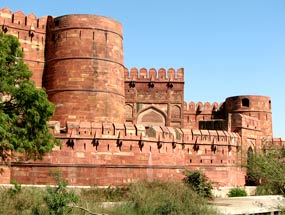Agra Fort, also known as the Red Fort of Agra,
was constructed in the 16th century. Know more about Agra Red Fort,
India.
Agra Fort

Location: Agra, Uttar Pradesh
Founded By: Emperor Akbar
Time of Construction: 1565 to 1573
Best Time to Visit: November to February
Timings: 6:00 am to 5:30 pm (Daily)
Interesting Facts: Agra Fort won the 'Aga Khan Award for
Architecture' in the year 2004. Indian Post issued a Stamp to
commemorate the Aga Khan Award on 28th November 2004.
Agra Fort, situated on the banks of River Yamuna, dates back to the
16th century. Mughal Emperor Akbar laid down the foundation of the fort,
in the year 1565. As many as 4000 builders were involved in the
construction of Agra Fort for a period of eight years and completed it
in 1573. Agra Red Fort has been built in the shape of a crescent, which
is flattened on the east with a long wall that faces River Yamuna. Built
out of red sandstone, the fort lies 2 km to the northwest of the
magnificent Taj Mahal.
The Red Fort of Agra stands enclosed within massive double walls, which
rise to a height of 69 ft and have a circumference of 2.5 km. The walls
have two entry gates, known as the Delhi Gate and the Lahore Gate or
Amar Singh Gate. The Delhi Gate initially provided entrance to the fort
and led to the inner portal, called the Hathi Pol or Elephant Gate.
Encircled by a moat, Agra fort has a number of buildings within its
complex and is a city within itself. There are a number of palaces
inside the fort complex, along with numerous splendid mosques.
Presently, entrance to the fort has been limited to the Amar Singh Gate
only. However, the general public is granted access from the southern
part of the Agra Fort, which provides admission to almost all the
buildings. Of the numerous structures inside the fort complex, the most
popular ones are Jehangir Mahal, Khas Mahal, Diwan-i-Aam and Sheesh
Mahal.
Jehangir Mahal
On entering the Agra Red Fort through the Amar Singh Gate, the first
building one comes across is the Jehangir Mahal. The mahal or palace
stands at the end of a lawn and was intended to serve as the residence
of Akbar's son, Jehangir. It holds the distinction of being the largest
private residence in the fort and has been built as per a blend of Hindu
and Central Asian architecture. The inner courtyard has a two-story
facade of beautiful halls with exceptional carvings. The verandah on the
eastern front has slender pillars and faces the Yamuna.
Khas Mahal
A white marble monument, Khas Mahal was built by Shah Jahan in 1637. It
has been built as per Islamic-Persian architecture and has three
pavilions, along with a magnificent fountain. Two of the pavilions are
golden in color, out of which one is believed to be adorned with gold
leaf.
Musamman Burj
Musamman Burj lies to the left of the Khas Mahal and is an octagonal
tower with an open pavilion. Shah Jahan got this tower built for his
wife, Mumtaz Mahal. Musamman tower is made of marble lattices and is
adorned with a marble dome. There is also a verandah, with a carved
fountain in the center. It was here that Shah Jahan spent the last few
years of his life, after being captured by his son Aurangazeb.
Diwani-i-Khas
Shah Jahan got the Diwan-i-Khas, the hall of private audience,
constructed in 1636-37. It was here that he used to receive kings,
dignitaries and ambassadors. A three-sided pavilion, it has marble
throne terrace, where a pair of thrones have been kept. Presently,
general public is not allowed inside the Diwan-i-Khas.
Sheesh Mahal
Sheesh Mahal, the Glass Palace, is situated opposite the Mussaman Burj
and below the Diwan-i-Khas. The royal dressing room of the Mughals, this
palace has two large halls of equal size and has been inlaid with small
mirrors.
Macchhi Bhawan
Macchhi Bhawan, a grand enclosure opposite Diwan-i-Khas, was used for
harem functions. The pools and marble fountains, which once adorned the
enclosure, were taken by Jat Raja Surajmal to his Deeg palace.
Hammam-i-Shahi
Hammam-i-Shahi, or the Shah Burj, is an apartment that was attached to
the residential quarters and served as a summer retreat.
Diwan-i-Aam
Diwan-i-Aam, the hall of public audiences, is a red sandstone monument
constructed by Shah Jahan. The emperor used to meet his officials as
well as the commoners here only. The famous Peacock Throne of Shah Jahan
was kept here only.
Nagina Masjid
Nagina Masjid, the Gem Mosque, was the private mosque of Shah Jahan,
with typical cusped arches for the ladies of the court.
Moti Masjid
Moti Masjid, the Pearl Mosque, is a perfectly proportional white marble
monument, adorned with three domes.
How to Reach Agra Red Fort
By Air: The airport of Agra is well connected with almost all
the major cities of the country.
By Rail: Agra is a major railway junction and has several
railway stations, with the Agra Cantonment Railway station being the
main one.
By Road: Agra has regular bus services to almost all the cities
in UP as well as other states.


